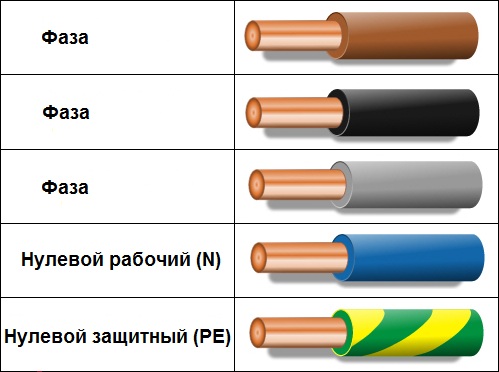Categories: Featured Articles » Novice electricians
Number of views: 40,038
Comments on the article: 7
Wire color coding
 Color insulation of conductors today is an integral attribute for the successful and proper installation of electrical wiring. Such a solution is by no means a way to make the wires beautiful and attractive to the consumer, it is a convenient color marking, standardized and regulated throughout the civilized world, which is, without exaggeration, a necessity.
Color insulation of conductors today is an integral attribute for the successful and proper installation of electrical wiring. Such a solution is by no means a way to make the wires beautiful and attractive to the consumer, it is a convenient color marking, standardized and regulated throughout the civilized world, which is, without exaggeration, a necessity.
The color marking of the wires gives an exact designation to each conductor, the color of the insulation of the core marks its purpose in a group of several conductors, and facilitates the process of switching and installation. This solution eliminates errors that may occur during installation, which could lead to a fatal electric shock or short circuit. Repairing and maintaining electrical networks also becomes safer if the wires are precisely labeled.
The standard set out in the PUE strictly defines the colors of marking, and thanks to this standard, it becomes possible to easily identify each conductor, each cable core in a group by color or by alphanumeric code.
As a rule, the conductor as a whole has a certain color, but marking only of the ends of individual cores is permissible, at switching points where the use of colored electrical tape or colored cambric is possible. Further we will consider in more detail how exactly such marking is performed for single-phase, three-phase current and direct current networks.
Standard color coding of busbars and wires for three-phase AC networks:
In three-phase alternating current networks, high voltage transformer inputs both at stations and substations, as well as buses, are painted in the following colors, corresponding to the phases:
-
Phase "A" - painted in yellow;
-
Phase "B" - painted in green;
-
Phase C is colored red.

Standard color coding for wires and DC busbars:
For DC circuits, only two buses are characteristic: positive and negative. Here, the positive wire (positive charge bus) is marked in red, and the negative wire (negative charge bus) is marked in blue, because the zero and phase wires are essentially absent here. The middle wire (M) is marked in blue.
In the case where a DC network containing two conductors is created by branching from a three-wire DC circuit, the conductors are marked in the same way as the corresponding conductors of the original three-wire circuit.
Phase, zero and ground in the wiring:
Electrical AC networks are now always laid with a stranded wire in the insulation of cores of different colors, this greatly facilitates the installation process. If the wiring is done by one installer, and in the future other people will carry out network maintenance and repair, they will no longer be forced to constantly identify "Phase" and "zero", they just orient in color.
But in the old days, this was a real problem, because the isolation was used monochromatic - either white or black. Now the standard has been developed, and in accordance with GOST R 50462 "Identification of conductors by color or digital designation", the cores are separate and in cables have strictly regulated designations.
The marking function is to create the ability to quickly and easily clearly determine the purpose of each specific conductor in any of its sections, this is one of the main requirements of the PUE.
What color according to GOST must conductors in electrical installations of alternating current for voltage up to 1000 volts and with earthed neutral, which almost all residential buildings and office buildings belong to, have?
Zero conductor (N) is blue.For the neutral protective conductor (PE) - yellow-green marking in the form of strips along or across the core. Such marking in the mentioned color combination is relevant only for grounding conductors (for zero protective).
When the neutral conductor is made aligned with zero protective (PEN), then along the entire length of the wire the marking is done in blue, and at the points of connections (at the ends of the conductor) - yellow-green stripes, or vice versa: a yellow-green conductor with blue ends.
So, zero wires are marked with the following colors:
-
Zero working wire (N) - marking in blue;
-
Zero protective conductor (PE) - marking yellow-green;
-
Zero Aligned Wire (PEN) - yellow-green marking with blue marks at the ends or vice versa (see above).
Phase wires, in accordance with the PUE standard, can be marked with one of these colors: red, black, purple, brown, gray, pink, orange, turquoise, or white.

If a single-phase electric circuit is obtained by branching from a three-phase network, then the phase wire of the obtained single-phase circuit must necessarily match the color of the original wire of the three-phase network from which the branch is made.
The wires are marked so that the colors of the phase wires do not in any way match the color of the neutral conductor. And if an unlabeled cable is used, then color marks are made at the ends of the cores, at the joints, using shrink sleeves or colored electrical tape. But to prevent unnecessary work on the manufacture of labels, it is enough to initially choose the right color of insulation, choosing a cable of sufficient length for your needs.
Sometimes an electrician in work has to deal with not very pleasant situations when the wiring is already completed, and neither the connections in the panel, nor the wires are marked, in this case a person has to spend time and, using a probe, detect “phase”, “zero”, and “ground”.
However, it should always be remembered that even if it is not possible to purchase a wire of the desired color, you can certainly use a wire of any color, but then you must definitely mark the ends of the wires with at least colored heat shrink or colored electrical tape. And always remember that when wiring, you must be careful and always follow safety precautions.
See also at i.electricianexp.com
:
